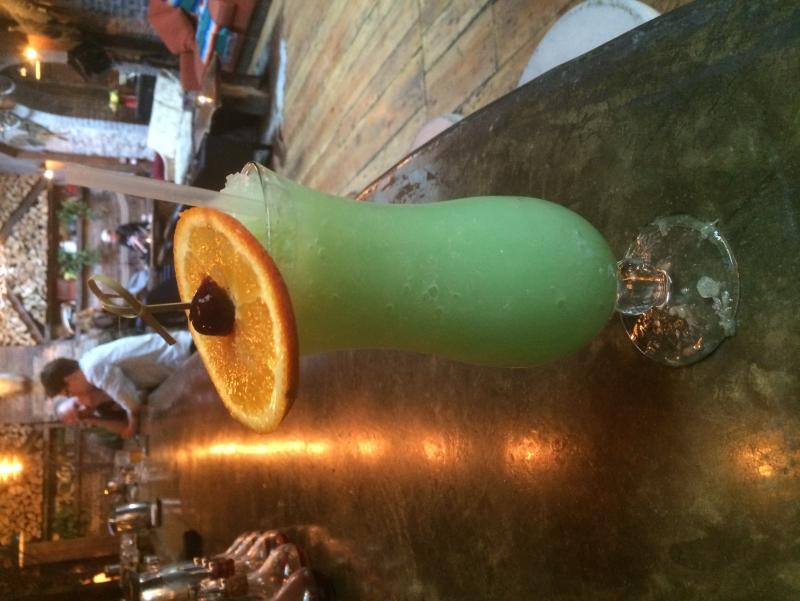-
Posts
900 -
Joined
-
Last visited
Content Type
Profiles
Forums
Store
Help Articles
Posts posted by Rafa
-
-
There's also the Flor de Jerez.
-
 2
2
-
-
I like a nice fino or manzanilla sherry with a good tonic like fever tree, and maybe a bit of gin for fortification. Cynar makes a nice accent when you're feeling sinister.
-
 3
3
-
-
Yes, sadly, I hear all over that the art of drink (and, worse, food) is not what it once was in Havana. If only someone or someones would thoroughly study the old Cuban style and devote themselves to reviving it... ;-)Don't doubt the sophistication of Havana bars in the heyday of Cuba as America's prohibition and post prohibition playground. Cuba in the mid 2000's after the collapse of the Soviet Union is a more than just as little bit of a wildcard and based on my experience of Cuba in 2013, when things had started to pick up again at least a little bit with the arrival of European and Canadian tourists, I was more than a little underwhelmed.
No doubt some bars are still doing it the right away but I don't think the odds of finding one at random now or in the past decade or two were not necessarily in your favor (the quality of the "Mai Tai" Wayne Curtis described in his article being a case in point!). Perhaps he knew where he was going and it was a quality locale but not every tourist is likely to have the same cocktail acumen!
-
 1
1
-
-
The original recipe specifies "Vermouth de Chambery" rather than "francés" or "seco," as is specified elsewhere in the same book, which is what leads Wondrich, Berry, etc. to assert that the proper vermouth is probably Dolin Blanc (or similar). At any rate, the blanc style makes the better drink. The authors call for 1-2 barspoons of either curaçao or grenadine, which indicates to me that the small amount of sweetener serves to 1) sweeten the drink further while adding a bit of flavor complexity, 2) dye the drink red (curaçaos were more often red—or green, as well as the usual orange, clear, and blue—back then). I prefer a dry orange liqueur in mine and don't see the point of having both options, but to each his bliss. As far as vermouth storage, Havana's bars in the 20s (and well into the 40s) were among the most sophisticated and successful in the hemisphere, as evidenced by the wide array of international ingredients and the mixological know-how called for by these old recipes. I'm sure they knew from proper wine maintenance.
-
 4
4
-
-
Without, always.
-
I have no recollection of writing that.
-
Gorgeous garnish.
-
Fino and tonic is a delicious variation on the Rebujito—tastes like bitter apple juice.
-
 1
1
-
-
That's Sixpoint's excellent Jammer gose in my world's skinniest beer glass.
-
 1
1
-
-
A Lion's Tail, I guess:
2 oz Angel's Envy rye
3/4 oz lemon juice
1/2 oz honey syrup
1/4 oz St. Liz
Christmassy. I'll be tossing back a lot of these come fall.
-
 1
1
-
-
Tonight I had a Pearl of Puebla by Jim Meehan (Sombra mezcal, yellow Chartreuse, lime, oregano, Ricard, agave). Perfect. Delicious.
-
I used Senior's blue Curaçao, which has a neutral spirits base and is closer to Cointreau. I also used homemade, not particularly sweet orgeat, and fresh-juiced pineapple with nice acidity—Trader Joe's' otherwise excellent cartoned pineapple juice might be a bit insipid here.
-
 1
1
-
-
-
Absinthe blue Mai Tai, all day every day:
2 oz pineapple juice
1 oz St. George absinthe
1 oz orgeat
1 oz lime juice
1/2 oz Senior blue curaçao
1/2 oz Wray & Nephew, as float
Crushed ice and orange flag
-
 1
1
-
-
Last night a slightly altered Jet Pilot:
1 1/4 oz Appleton VX
1/2 oz Smith & Cross
1/4 oz Blackstrap
1 oz grapefruit
3/4 oz lime juice
1/2 oz honey
1/2 oz cinnamon
1 dash absinthe
1 dash ango
Crushed ice
-
 2
2
-
-
-
Stephen, it's interesting you mention this:
You want ethyl acetate as close to the recognition threshold as possible without going over. When you go over the recognition threshold, ethyl acetate will smell like nail polish remover, but when below (but well above the absolute threshold), ethyl acetate will be a bridge for the other aromas. Without ethyl acetate to bridge aromas, they will be perceived as disparate and possibly dissonant. The fixative term is used in many different ways but here it brings aromas together (spatially in the mind) to create unique and extraordinary percepts. A large part of distilling and blending is managing ethyl acetate.I believe Bryan's stated that he tries to keep ethyl acetate as low as possible in his rums. I think he's an extremely talented autodidact but this is one place where his research seems to have failed him.
-
 2
2
-
-
I don't find Pusser's and the LS Navy very similar. The Navy is my least favorite of the Lost Spirits uh, spirits I've tried; it's loaded with flavor compounds, but doesn't walk me through them in any interesting way. My sense is Bryan and co. put a lot of energy into maximizing flavor density without thinking through how flavors interact, the role of "fixatives" (thanks bostonapothecary) in flavor perception and interaction, and other facets of distilling and blending that don't show up on a chromatogram. For Bryan Davis' next trick I'd like him to consider harmony.
I can't recommend bostonapothecary's library of found distillation research enough to anyone interested in how spirits and flavors are made. And Stephen's thinking on perception and what's ickily called neurogastronomy is still ahead of its time and worth reading.
-
 3
3
-
-
1 1/2 oz Laphroaig 10
1/2 oz Smith & Cross
3/4 oz ginger syrup
3/4 oz lime juice
Finish for days.
-
 2
2
-
-
Both are excellent, but the Clément is more flavorful and aromatic, and I find myself craving it more.
-
 2
2
-
-
3/4 oz gin
3/4 oz Solbeso
3/4 oz dry sake
3/4 oz lemon
3/4 oz jasmine green tea syrup
Yes.
1 1/2 oz bourbon
1/2 oz Appleton VX
1/4 oz Giffard grapefruit
1/4 oz ginger syrup
1 tsp Fernet Branca
Julep build with crushed ice and mint
Yes yes.
-
 2
2
-
-
I am in the middle of designing a drinks menu and thus sick of cocktails so Damoiseau VSOP, Clément VSOP, and Don Q 151 neat have been my Drinks! 2014 (Part 2) lately.
-
 2
2
-
-
Very much an end of shift drink. Not For Everyone.
-
Sounds a lot like the Gosling's Very Old I had at Hassouni's place—I wonder what happens during fermentation or maturation to bring out these eucalyptus/fernet notes?





Sasha Petraske (1973-2015)
in Food Traditions & Culture
Posted
Terrible news. Sasha Petraske, who founded Milk & Honey and helped usher in our current renaissance of fine drinking, has died.
Anyone who enjoys a well-made drink in 2015 is indebted to Petraske. At Milk & Honey, and at all the bars started by him and his acolytes, he re-introduced imbibers to jiggered, deeply researched, craftily made classics, both old and new. Going to one of his bars was a special occasion: memorable, mysterious, unapologetically adult. His staffs were as professional as they were hospitable, as serious as they are fun. He elevated the craft. He raised the bar.
I never knew him, but as a cocktail bartender I owe him so much. He helped create the environment in this city, among bartenders and guests alike, that makes so much of what we do possible. Like many, I got my first education in classic drinks through Milk & Honey's official app, Bartender's Choice; I still use it as a reference to introduce people to the ratios and recipes of the classics.
Rest in peace.